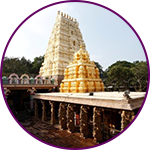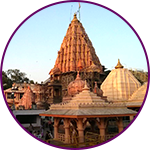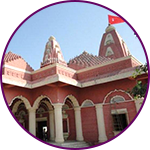Significance of Pujas At Trimbakeshwar Temple (Tryambakeshwar), Nasik (MH, India)
Trimbakeshwar (Tryambakeshwar) temple is one of the prime ancient temples in India dedicated to Lord Shiva. Located in Trimbak (Trimbakeshwar tehsil) in the Nashik District of Maharashtra, the Temple is regarded as one of the twelve sacred Jyotirlingas. Also, it is important to note that the longest river Godavari originates near Trimbak. The temple premises have a holy kunda (pond) called Kusavarta which is the source of Godavari.
This place is renowned and glorified for Shiva pujas and also the numerous religious rituals (vidhis) such as Narayan Nagbali, Kalsarpa Shanti, Tripindi vidhi and all types of Shradh rituals for the deceased. Ancient scriptures such as Dharma Sindhu mention that the religious rites and rituals for pacifying the departed souls and for relieving oneself of Kaal Sarpa dosha should be performed only at Trimbakeshwar. This is also corroborated in the scriptures like Skanda Purana and Padma Purana.
Ancient significance of the temple

The Temple houses three Lingams associated with Brahma, Vishnu and Mahesha (Shiva) with a water body called Amritavarshini (meaning the rain of nectar) as well as Bilvatheertha, Viswananthirtha and Mukundathirtha, being other water bodies. One can see the ancient images of various deities such as Gangadevi, Jaleswara, Rameswara, Gautameswara, Kedarnath, Rama, Krishna, Parasurama and Lakshmi Narayana inside the Temple.
It is located between three important hills Brahmagiri, Nilagiri and Kalagiri. In the Brahma Purana, the Gautami Mahatmaya (Chapter Five), it is stated Lord Brahma to create moving and non-moving living entities selected the Devayajana Mountains for tapasya (sacrifice). These Mountains were later called as Brahmagiri meaning the hilly regions of Brahma. In the Brahmagiri, there’s a river called River Gautami. Gautama Maharishi and his wife Ahalya lived here. Once the Maharishi accidentally killed a cow (maya dhenu) which was actually a celestial cow sent my Lord Ganesha. To atone for this grievous sin, the Maharishi travelled to Nashik and observed tapasya in order to please Lord Tryambakeshwara (Shiva). He asked Shiva to send the Ganges over the cow (to liberate her). Pleased by his tapasya, Shiva diverted Ganges cleansing the cow, which led to the emergence of River Godavari.
Jyotirlinga at Tryambakeshwar
A Jyotirlinga is a sacred light signifying the Supreme Shiva. The Sanskrit word ‘Jyoti’ means radiance, and ‘lingam’ means a diving form personifying Shiva. Jyotir Lingam, therefore, means luminous or the radiant light of Shiva. There are twelve traditional Jyotirlinga shrines in India.
The Shiva Purana mentions that when Bramha and Vishnu argued over their supremacy of creation; Lord Shiva pierced the universe by being an endless beam of light. Both Brahman nor Vishnu could not find the ends of the Light which represented the infinite powers of Shiva. The Light fell on the earth at twelve places, and these places or shrines are now said to be the Jyotirlingas. The Jyotirlinga is the Supreme Shiva Himself also represented and known as Lingodbhava.
There are total of twelve Jyotirlingas, including the Trimbakeshwar one. The other eleven are:

Trimbakeshwar
(Nashik)

Kedarnath (Himalayas)

Vishwanath temple

Mallikarjuna

Bhimashankar ((Maharashtra)

Vaidyanath -Deoghar in Jharkhand

Mahakaleswar (Ujjain, Madhya Pradesh)

Grishneshwar (Aurangabad, Maharashtra)

Nageshwara Jyotirlinga (Dwarka, Gujarat)

Omkareshwar (Madhya Pradesh)

Somnath, Gujarat

Rameshwar (Rameswaram in Tamil Nadu)
Pujas performed at the Trimbakeshwar (Tryambakeshwara)

The Trimbak temple is well-known for Shiva Pujas like Rudra Abhishek, Mahamrityunjaya japa, Rudram and Vedic rituals, especially Narayan Nagbali, Kalsarpa Shanti and Tripindi Shraddh that are performed here only in the whole of the country.
Narayana Bali and Nagabali
Narayan Bali Puja is described in the Garuda Purana. It is performed to satisfy and liberate one’s Pitru (ancestors) from the bondage caused by unnatural death due to starvation, animals, accident, arson, curse, epidemics such as cholera or other diseases causing untimely death, suicide,, fall from a mountain, tree or any height, drowning, murder, snake bite and lightning.
When a man dies (accidentally or untimely) with an unfulfilled desire, he (soul) does not attain Mukti (liberation) and roams around the earthly atmosphere inflicted with the unfulfilled desire. Every soul after death goes toward the Sun (a divine aspect of the Lord), but certain unfulfilled desires don’t let them do so. So the soul of the departed man creates problems such as struggles, poverty, accidents, mental stress, ancestral curse, family disputes etc. for his descendants. Therefore it is important to perform Naryana Bail puja in order to pacify and liberate one’s ancestors.
Nagabali Puja was recommended by Shaunak Rishi (Bhagvat Purana). It is performed to get rid of the sin of killing a snake-like Cobra, which is revered in scriptures and worshipped in India. When a man collects material objects or is too attached to a material object letting no one touch or use it, he dies like a snake seated on that object. So if you come across such a snake (who was the possessive man in its previous birth) and kill it accidentally, you are cursed by the snake. And the curse results in various bodily diseases or physical pains. Therefore, to get rid of such diseases, it is important to perform Nagabali Puja.
Kaal Sarpa Dosha Shanti
BOOK YOUR KAAL SARP DOSHA NIVARAN PUJA
Kaal Sarpa Dosha ShantiKaal Sarpa Shanti puja is performed to nullify Kaal Sarpa Dosha which negatively impacts every aspect (personal, professional social etc.) of your life. A person afflicted with the Kaal Sarpa Dosha is said to experience the unusual such as seeing the dead or recently departed family members in his dreams.
Issues caused include delays and obstacles, emotional instability, low confidence, bad health, loss of wealth, irrecoverable business losses, mental anxiety, deception by friends or enemies, no support from dear ones, endless struggles and not enough credit for the efforts.
What causes this Dosha? If a person kills or causes the death of a snake or an innocent animal, he attains the Kaal Sarpa Dosha in his next birth. So, the current unexpected problems are the results of Kaal Sarpa Dosha due to killing a snake or an innocent animal in the previous birth. In Vedic astrology, when all the seven planets come between Rahu and Ketu, he is said to have this dosha.
Types of Kaal Sarpa Dosha
-
Types of Dosha:
Ananta Kaal Sarpa
Due To: Rahu is placed in the 1st House and Ketu in the 7th House
Results/Consequences: Bad Marital Life, Inferiority Complex and Mental Anxiety -
Types of Dosha:
Kulik Kaal Sarpa
Due To: Rahu is placed in the 2nd House and Ketu in the 8th House
Results/Consequences: Bad Health, Accidents, Bad Reputation, Financial Losses -
Types of Dosha:
Vasuki Kaal Sarpa
Due To: Rahu is placed in the 3rd House and Ketu in the 9th House with the planets on the left of both
Results/Consequences: High Blood Pressure, Untimely Death, Business Losses Due to Relatives -
Types of Dosha:
Shankha Pal Kaal Sarpa
Due To: Rahu is placed in the 4rth House and Ketu in the 10th House
Results/Consequences: Problem at workplace, Stress, Hardships -
Types of Dosha:
Padam Kaal Sarpa
Due To: Rahu is placed in the 5th House and Ketu in the 11th House
Results/Consequences: Constant Fear of Child, Difficulty in Conceiving, Chronic Illnesses, Delays in Academic Successes -
Types of Dosha:
Maha Padam Kaal Sarpa
Due To: Rahu is placed in the 6th House and Ketu in the 12th House
Results/Consequences: Problems From Enemies, Inherited Diseases -
Types of Dosha:
Takshak Kaal Sarpa
Due To: Rahu is placed in the 7th House and Ketu in the 1st House
Results/Consequences: Constant Speculation of wealth, Loss of Wealth due to Alcoholic Tendencies, Gambling, Unhappy Married Life -
Types of Dosha:
Karkotak Kaal Sarpa
Due To: Rahu is placed in the 8th House and Ketu in the 2nd House
Results/Consequences: Short-temperedness, Many Enemies, Antisocial Activities, Loss of Ancestral Assets or Properties, Sexually Transmitted Ailments -
Types of Dosha:
Shanka Chood Kaal Sarpa
Due To: Rahu is placed in the 9th House and Ketu in the 3rd House
Results/Consequences: Ups and Downs, Lying, Anti-religious or Anti-spiritual deeds, Mental Anxiety and High Blood Pressure -
Types of Dosha:
Ghatak Kaal Sarpa
Due To: Rahu is placed in the 10th House and Ketu in the 4th House
Results/Consequences: Legal Cases, Punishments -
Types of Dosha:
Vishdhar Kaal Sarpa
Due To: Rahu is placed in the 11th House and Ketu in the 5th House
Results/Consequences: Unstability, Frequent Travel, Problems with Children at Home, Imprisonment, No Support from Brothers, Sisters or Cousins -
Types of Dosha:
Sheshnaag Kaal Sarpa
Due To: Rahu is placed in the 12th House and Ketu in the 6th House
Results/Consequences: Litigation issues, Losing Cases, Enemies and Bad Health
To nullify Kaal Sarpa Doshas, it is important to perform Kaal Sarpa Dosha Nivaran Puja at Trimbakeshwar.
Tripindi Shraadh Puja
BOOK YOUR TRIPINDI SHRAADH PUJA
Kaal Sarpa Dosha ShantiIt is a Vedic ritual performed to appease and pacify the departed ancestors who dwell in the Preta Yoni due to their descendants in the family failing to offer Shraadh to them. Ideally, one should regularly offer Shraadh (blessed food) to their ancestors. If one fails to offer Shraadh for three consecutive years, one suffers from this dosha. Therefore one should offer Shraadh to the departed souls every year on their death anniversary. Additionally, the Shraadh ceremony should be performed in the Pitrapaksh of the month of Bhadrapad.
Why Narayan Naga Bali, Kaal Sarpa Vidhi and Tripindi Shraadh Puja are performed at the Trimbakeshwar (Trayambakeshwar) only?
Trimbakeshwar temple houses three Lingams associated with Brahma, Vishnu and Mahesha (Shiva) with the ancient images of various deities such as Gangadevi, Jaleswara, Rameswara, Gautameswara, Kedarnath, Rama, Krishna, Parasurama and Lakshmi Narayana. All these aspects make the Temple the holiest, the most sacred, the most auspicious and the most divine where the reactions of sins, demonic acts etc. are curbed, curtailed and nullified. It is this Temple where River Godavari originates, and who is the purity personified at the feet of Shiva washing away the sins of surrendered living beings. Another reason is Lord Shiva’s absolute divinity. It is mentioned in the Bhagavat Purana (8.7.22) that when the poison Halahala was produced during the churning of the Ocean (Samudra Manthana) for the nectar of immortality, the Prajapatis prayed to Shiva this way:
त्वमेकः सर्वजगत ईश्वरो बन्धमोक्षयोः । तं त्वामर्चन्ति कुशलाः प्रपन्नार्तिहरं गुरुम् ॥२२॥
“O lord, you are the cause of bondage and liberation of the entire universe because you are its ruler. Those who are advanced in spiritual consciousness surrender unto you, and therefore you are the cause of mitigating their distresses, and you are also the cause of their liberation. We, therefore, worship Your Lordship.” (Bhagavata Purana 8.7.22)
At the request of the Prajapatis, demi gods and other heavenly personalities, Lord Shiva said to His consort Bhavani (Parvati) (Bhagavata Purana 8.7.38)
आसां प्राणपरीप्सूनां विधेयमभयं हि मे एतावान्हि प्रभोरर्थो यद् दीनपरिपालनम्
‘It is my duty to give protection and safety to all living entities struggling for existence. Lord Shiva, who is always devoted to auspicious, benevolent work for living beings, compassionately took the whole poison in his palm and drank it. Thus all of them were saved.
This event describes that only Lord Shiva takes charge of the sinners. The Prajapatis said that Shiva is the cause of mitigating the distresses. Therefore It is He only who took the deadliest poison and saved living beings scattered all over the universe. It is He only who can liberate the suffering living beings. It is He only who can purify the malicious and rectify the dosha-stricken people.
‘Trayambak’ means the Three-Eyed. Lord Shiva is addressed as the ruler in the above verse, indicating he is the master of past, present and future, the three modes (guna) of material nature (Sato, Tamo and Rajo), Creation, Maintenance and Destruction etc. It is Shiva only who knows the past, present and future births of living beings. Therefore, it is very important to pacify all the Pitrus (ancestors) and the snakes at the lotus feet of Shiva by whose mercy the Godavari flows washing away the sins accrued even from the previous births.
Rudra Abhishek
.jpg)
‘Rudra’ means the one who is terribly infuriated, which is one of the divine qualities of Lord Shiva, who causes a change in the form of destruction of ego, illusions and the false identification with the matter. While under destruction, nothing is actually destroyed but the illusion of individuality. Abhishek means a method of worship offered to the Divine who opens a new path by destroying ego and false identification with one’s material existence. Mahadev is Satyam, Shivam, Sundaram or Truth, Goodness and Beauty that cannot be surpassed. Shiva signifies the most essential goodness.
Performing Rudra Abhishek includes the offerings of Panchamrit (mix of milk, honey, sugar, ghee and curd, ganga jal, ghee, rice grains, bael patra (bilva leaves) and other sacred items. It purifies your mind and body, offers peace, fulfils your desires and enlightens your soul.
Rudraksha Abhishek performed in Trayambakeshwar is highly auspicious and immensely rewarding or beneficial.
RUDRA CENTRE TEMPLE IN TRIMBAKESWAR
Rudra Centre has its own divine temple in this holy city. Narayan Nagbali, Kaal Sarpa Dosha, and Tripinda Shraadh pujas are performed here by the able karmakandi Pundits. All the rituals are performed as instructed in the scriptures.
Location
Address: Rudra Centre Puja Services, 69 Panch Aali, Opposite Shivaji Taleem, Trimbakeshwar, Nashik - 422212
Tripindi Shraadh Puja at Trayambakeshwar by Rudra Centre

- This puja is performed to provide liberation and peace to the souls of one's ancestors. It is best for providing cordial and harmonious family relations.
- It is also performed for relief from physical, and mental ailments, as well as financial stability and peace of mind.
Kaal Sarp Dosha Nivaran Puja at Trayambakeshwar by Rudra Centre

- This puja is performed to provide professional and personal stability, remove hurdles in the way to success, provide harmony and peace of mind
- It is also performed for relief from other malefic effects of the Kaal Sarp Dosha.
Rudra Abhishek at Trayambakeshwar by Rudra Centre

- This ritual is performed for those who suffer from being overly attached to material objects and seek spiritual upliftment.
- It is performed for the removal of all planetary Doshas and for the longevity of life.






-Mochan-In-Sanatan-Dharma-B.jpg)

Comments 0
Leave your thought here